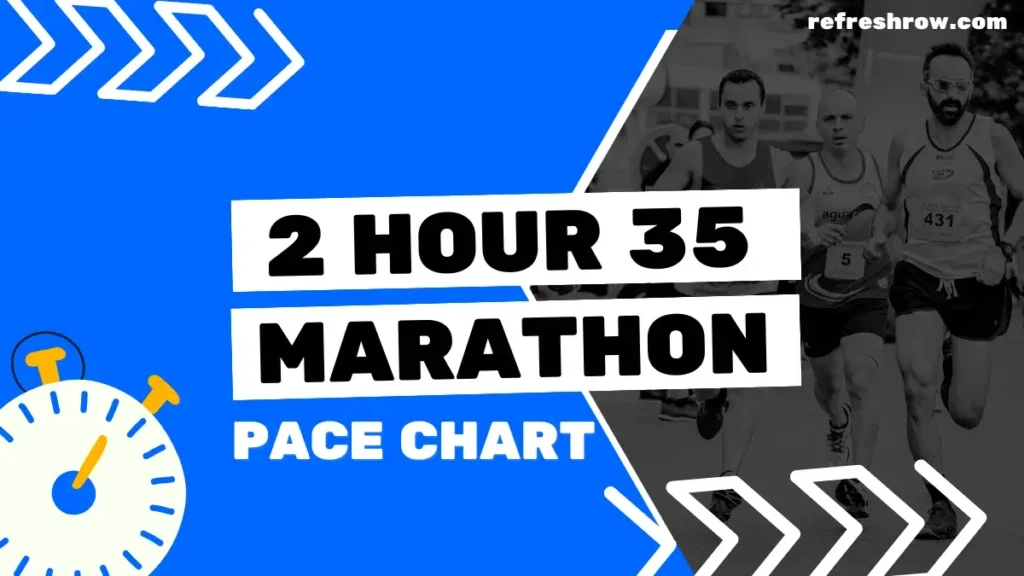To run a 3:20 hour marathon you need to run at a pace of 7:38 per mile or 4:44 per kilometer.
Following the splits below (and shaving off a second), you’ll run a sub 3:20 marathon.
I’d recommend aiming to run 1-2 minutes ahead of the split target time from 10 miles, as you’ll likely come up against crowding on race day.
3:20 Marathon Pace in Miles
| Mile | Split |
|---|---|
| 1 | 7:38 |
| 2 | 15:15 |
| 3 | 22:53 |
| 4 | 30:31 |
| 5 | 38:08 |
| 6 | 45:46 |
| 7 | 53:24 |
| 8 | 1:01:02 |
| 9 | 1:08:39 |
| 10 | 1:16:17 |
| 11 | 1:23:55 |
| 12 | 1:31:32 |
| 13 | 1:39:10 |
| 14 | 1:46:48 |
| 15 | 1:54:25 |
| 16 | 2:02:03 |
| 17 | 2:09:41 |
| 18 | 2:17:18 |
| 19 | 2:24:56 |
| 20 | 2:32:34 |
| 21 | 2:40:11 |
| 22 | 2:47:49 |
| 23 | 2:55:27 |
| 24 | 3:03:05 |
| 25 | 3:10:42 |
| 26 | 3:18:20 |
| 26.2 | 3:20:00 |
Download
3:20 Marathon Pace in KM
| KM | Split |
|---|---|
| 1 | 4:44 |
| 2 | 9:29 |
| 3 | 14:13 |
| 4 | 18:58 |
| 5 | 23:42 |
| 6 | 28:26 |
| 7 | 33:11 |
| 8 | 37:55 |
| 9 | 42:40 |
| 10 | 47:24 |
| 11 | 52:08 |
| 12 | 56:53 |
| 13 | 1:01:37 |
| 14 | 1:06:22 |
| 15 | 1:11:06 |
| 16 | 1:15:50 |
| 17 | 1:20:35 |
| 18 | 1:25:19 |
| 19 | 1:30:03 |
| 20 | 1:34:48 |
| 21 | 1:39:32 |
| 22 | 1:44:17 |
| 23 | 1:49:01 |
| 24 | 1:53:45 |
| 25 | 1:58:30 |
| 26 | 2:03:14 |
| 27 | 2:07:59 |
| 28 | 2:12:43 |
| 29 | 2:17:27 |
| 30 | 2:22:12 |
| 31 | 2:26:56 |
| 32 | 2:31:41 |
| 33 | 2:36:25 |
| 34 | 2:41:09 |
| 35 | 2:45:54 |
| 36 | 2:50:38 |
| 37 | 2:55:23 |
| 38 | 3:00:07 |
| 39 | 3:04:51 |
| 40 | 3:09:36 |
| 41 | 3:14:20 |
| 42 | 3:19:05 |
| 42.2 | 3:20:00 |
Download
Other Marathon Pace Charts
Targeting a different time?
Check out the Full Marathon Pace Chart in Miles or KM
Or select a specific finishing time below:
| 3:00 | 4:00 | 5:00 | |
| 3:05 | 4:05 | 5:15 | |
| 3:10 | 4:10 | 5:30 | |
| 3:15 | 4:15 | 5:45 | |
| 3:20 | 4:20 | 6:00 | |
| 3:25 | 4:25 | 6:15 | |
| 2:30 | 3:30 | 4:30 | 6:30 |
| 2:35 | 3:35 | 4:35 | 6:45 |
| 2:40 | 3:40 | 4:40 | 7:00 |
| 2:45 | 3:45 | 4:45 | |
| 2:50 | 3:50 | 4:50 | |
| 2:55 | 3:55 | 4:55 |
Training for a 3:20 Marathon
Is 3:20 a Good Marathon Time?
Well, what do the stats say?
Run Repeat conducted a study that contains 19,614,975 marathon results from more than 32,335 races across the globe, here is how a 3:20 marathon compares against age and gender for the races recorded:
| Overall | You’re faster than 94.2% of all runners. |
| Male | You’re faster than 91.1% of males. |
| Female | You’re faster than 98.3% of females. |
| <20 | You’re faster than 91.0% of under 20s. |
| 20-29 | You’re faster than 91.2% of 20-29 year olds. |
| 30-39 | You’re faster than 92.0% of 30-39 year olds. |
| 40-49 | You’re faster than 94.6% of 40-49 year olds. |
| 50-59 | You’re faster than 98.0% of 50-59 year olds. |
| >60 | You’re faster than 99.6% of over 60s. |
Training Runs and Paces for a 3:20 Marathon
To break a 3:20 marathon you’ll need to do some serious distance in your training, I recommend at least 35 miles (56km) per week.
You’re also going to need to make sure you’ve crossed off these milestones for other race distances:
- A 5k in 20:50 mins
- A 10k in 43:20 mins
- A half marathon in 1 hour 31 mins
Training Paces
| Pace | Mins per Mile | Mins per KM |
|---|---|---|
| Easy | 8:35 | 5:20 |
| Steady | 7:38 | 4:44 |
| 10k | 6:59 | 4:20 |
| 5k | 6:42 | 4:10 |
| 1 Mile | 6:13 | 3:53 |
Weekly Mileage Targets
| Target Mileage: | Gradually increase your weekly mileage from 40 miles (64 km) to a peak of 68 miles (109 km). |
| Incremental Increase: | Increase mileage by approximately 10% each week, with every fourth week as a recovery week where mileage is reduced by 20-30%. Make sure to taper for the last 1-2 weeks. |
Long Run Structure
| Total Distance: | Build up to long runs of 20-22 miles (32-35 km). |
| Segment Example: | First 5 miles (8 km): Easy pace, heart rate 140-150 bpm (approximately 8:45/mile or 5:26/km). Next 1 mile (1.6 km): Fast pace at 6:30/mile (4:02/km). Next 5 miles (8 km): Medium effort, heart rate around 160 bpm (approximately 7:30/mile or 4:40/km). Repeat: Repeat the segment twice (5 miles easy, 1 mile fast, 5 miles medium), you can taper the final 2 miles if required. |
Why This Works: Incorporating varied paces within long runs enhances lactate tolerance, which helps on race day when you’ve got to maintain pace despite feeling fatigued. By practicing surges during a run, you can build up your physical and mental resilience (lots of elite marathon runners use these strategies during their training).
Alternating Long Runs: Alternate between structured long runs (easy/fast segments) and easier long runs. For easier long runs, maintain a steady, comfortable pace throughout, focusing on mileage rather than speed to aid recovery.
Speedwork Sessions
| Short Intervals: | – 800m repeats at 3:15 per interval (4:03/km). – Aim for 6-12 repetitions with equal time for recovery. |
| Mile Repeats: | – 1 mile repeats at 6:30 per mile (4:02/km). – Aim for 6-12 repetitions with a 1-2 minute recovery jog. |
| Longer Intervals: | – 2 mile repeats at 6:40 per mile (4:09/km). – Aim for 5-8 repetitions with a 2-3 minute recovery jog. |
Recovery and Rest Days
| Rest Days: | You don’t need to incorporate rest days if you are using recovery runs, but I recommend taking 1 (or a max of 2) per week to allow your body to recover and prevent overtraining. |
| Easy Run Days: | Include 1-2 easy run days per week at a relaxed pace of 9:00/mile (5:36/km), covering 5-10 miles (8-16 km) per day. Try to keep your heart rate below 140 bpm on easy days to ensure proper recovery and aerobic development. |
My Tips to Run a Sub 3:20 Marathon
Embrace the Power of Consistency
One of the most valuable lessons I’ve learned from training for a 3:20 marathon is the importance of consistency.
It’s not about hitting a home run with every workout, but rather about showing up day after day, even when it’s raining or my motivation was low and I was in a and mood.
I made it a point to stick to my training schedule, knowing that each run, no matter how short or easy, was building a foundation (I like to think of it like I’m building my CV, which I can look back on when the going gets tough, to prove to myself that I can do it).
Over time, these consistent efforts added up, leading to significant improvements in my endurance and speed.
Focus on Strength Training
Incorporating strength training into my routine was a game-changer for my marathon training.
Stronger muscles not only improved my running economy but also helped prevent injuries.
Two times a week, I dedicated time to exercises that targeted my core, glutes, and legs in the gym.
Squats, lunges, and planks became staples of my workout plan, using progressive overload to build muscle mass.
This focus on strength paid off, as I found myself running more efficiently and recovering more quickly from long runs.
Prioritize Recovery and Listen to Your Body
Recovery is just as crucial as the workouts themselves, so I learned to listen to my body and prioritize rest.
This meant incorporating rest days and ensuring I got enough sleep.
I also made use of foam rolling and stretching to keep my muscles in top shape.
When I felt signs of overtraining, I didn’t hesitate to take an extra rest day or switch to a light cross-training session.
This approach helped me avoid burnout and stay healthy throughout my training cycle.
Use Visualization Techniques
Before each long run or key workout, I would spend a few minutes visualizing myself running strong and steady, overcoming any challenges that might arise.
On race day, at the start line, this mental preparation really helped, I felt less nervous and more confident, able to stay focused and calm.
But it was especially invaluable in the latter stages of the marathon when fatigue set in and mood dropped and my brain started to questions my motives.


Row Brown is the founder of Refresh Row. He is a keen marathon runner, his favorite being the London Marathon. He’s now set himself the mission of Running the Entire Length of Spain, which is scheduled for late 2024.


